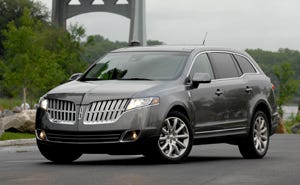Ford’s ‘Top Hat’ Strategy Unfolding in OakvilleFord’s ‘Top Hat’ Strategy Unfolding in Oakville
The MKT benefits from upgraded materials and added technology, but assembly tasks differ from the Flex and required some “unique” worker training.


BOULDER, CO – Ford Motor Co. no longer is talking through its hat about discontinuing the much-maligned practice of badge engineering, a top Ford engineer says.
“These are the first (vehicles) with fully differentiated top hats,” Chief Engineer Ron Heiser says of the cross/utility-vehicle platform-mates Ford Flex and the new-for-’10 Lincoln MKT.
“I think 95% of the people who look at MKT and Flex would never guess they’re off of the same platform and share a lot of common componentry, because they just don’t look alike,” he tells Ward’s at recent media event here.
MKT production is ramping up at Ford’s assembly plant in Oakville, ON, Canada. Scheduled for a late-summer showroom debut, the MKT is rolling off the same line as the Flex, which launched last year.
Pairing the vehicles on Ford’s D4 platform is the culmination of a plan formulated by Derrick Kuzak, group vice president-global product development. When Kuzak assumed his position in December 2006, he vowed to end the practice of tweaking platform-mates in favor of commonizing their respective underpinnings while giving each a distinctive design or “top hat.”
Ford has been promising to break the so-called badge-engineering habit since 2002.

’10 Lincoln MKT shares platform with Ford Flex.
Heiser has been in Oakville since January, tasked with prepping the plant for MKT production as well as training workers to equip the Flex and MKT with twin-turbo engines. The 3.5L V-6, which is branded EcoBoost and also features direct injection, offers enhanced performance without severely compromising fuel economy.
“We’re very much into standardizing our product-development process and our manufacturing bill of process,” Heiser says. “That minimizes unique operations.”
The MKT benefits from upgraded materials and added technology, which Heiser says required some “unique” worker training.
“The biggest difference. along with EcoBoost, is we're launching our electric power-assist steering,” he says. “So that’s a different assembly sequence than the hydraulic (steering) system.”
Oakville, which employs 3,000 hourly workers operating on two shifts, also produces the Ford Edge and Lincoln MKX CUVs. Sharing the auto maker’s CD3 platform, however, they feature similar sheet-metal.
Although Ford dramatically has trimmed its North American hourly workforce that hasn’t affected the quality of its vehicles, which has been on the rise.
Reduced staffing prompted by downsizing “has challenges,” Heiser admits. He credits the ongoing standardization of Ford’s manufacturing processes for with easing the transition to a smaller workforce.
“One of the things we’ve become good at disseminating lessons learned,” he says. “We’re much more collaborative among all the different functions within Ford, and that made us more efficient at launching vehicles.”
About the Author
You May Also Like

